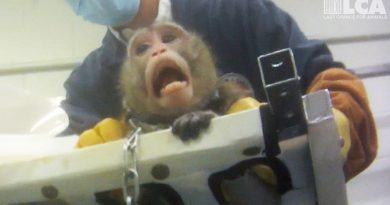Labelling Animals as Lab Subjects Changes Perceived Sentience
Image by Brian Gunn
Our thanks to Faunalytics for this excellent summary. Perception is everything in trying to create change. It’s important the public remembers that animals used in science are living beings who can feel joy, pain and are sentient.
Summary by Elena Schaller of Faunalytics. Original Study by Vezirian, K., Begue, L., & Bastian, B. (2024)
This study looks at how people think about animals used in labs compared to those in the wild, allowing them to justify their consumer choices.
Every year, an estimated 125 million animals are used in labs worldwide. While many countries have banned testing cosmetics on animals, drug testing still relies heavily on animals and makes up nearly half of all animal experiments. These tests can cause serious harm, including internal bleeding and paralysis.
Despite caring for animals, many people justify animal research in the name of scientific progress, especially for new medicines. But this reasoning often extends to non-essential products too, like skincare and household cleaners. To reduce the conflict, or cognitive dissonance, between their beliefs and habits, people tend to downplay the harm caused by animal testing. This is similar to what we see with the “meat paradox,” where people rationalize eating meat by ignoring the sentience of farmed animals. It’s easier to label animals as food or test subjects rather than face the reality of their suffering.
Researchers conducted four online studies with over 3,400 participants to see whether labeling animals as lab subjects and reminding people of their own consumer choices affect how they view these animals. Participants were recruited via the Prolific platform and had to be omnivores and speak English as a first language.
Animals In the Lab Versus Animals In The Wild
The goal of the first study was to find out if labeling animals as test subjects would make people see them as less mentally capable. Participants were asked about their use of 15 common medicinal, household, and self-care products — all clearly noted as animal-tested. They were then split into three groups: one group saw a picture of a rabbit in the wild (the control), another saw a rabbit in a lab with mild suffering, and the last group saw a rabbit in a lab with severe suffering. Participants rated the rabbit’s mental capacity (e.g., their ability to feel fear or pain) and indicated whether testing on the rabbit was justified.
The results showed that people thought rabbits in labs had fewer mental abilities than those in the wild, referred to as “mind denial.” Interestingly, people were more likely to justify animal testing in the control group and when the lab conditions seemed less harmful. In other words, when participants were faced with the suffering of animals used in labs, they found animal testing much harder to justify.
The Impact Of Animal Suffering
The second study was similar to the first, except that the researchers were more explicit in their descriptions of the pain caused by the experiment and the level of suffering experienced by the rabbit. As expected, participants rated a rabbit shown in the lab as less sentient than a rabbit in the wild. This suggests that, when people are reminded that their choices contribute to the harm faced by animals in labs, they instinctively downplay animal sentience.
The degree of suffering had no impact on participant ratings of mental capacities. This was surprising, as earlier research suggests that greater suffering usually leads people to deny their mental capacity even more. It’s possible that the format wasn’t engaging enough for participants to fully connect with the scenarios. Overall, the findings show that once animals are labeled as test subjects, people automatically see them as less sentient, regardless of how much suffering is shown.
The Impact Of Personal Responsibility
In the next study, the researchers explored whether feeling personally responsible for animal testing would affect how people see the animals. Participants reported their shopping habits for nine common medicinal, household, and self-care products and were then shown a picture of a beagle in a naturalistic setting (the control), in a lab where they were meant to feel less responsible, or in a lab where they were made to feel more responsible. Each group rated the beagle’s mental capacity.
Once again, beagles used in testing were consistently seen as less sentient than those in the control condition. Interestingly, the level of responsibility participants felt didn’t change this perception. Because animal testing is widespread and tied to scientific progress, it may be seen as a shared responsibility, leaving people less personally accountable for the harm.
Even when responsibility (this experiment) or suffering (the previous two experiments) was emphasized, perceptions didn’t change. This suggests that labeling animals as lab subjects has a stronger effect on how they’re perceived than individual responsibility or the level of harm involved. The motivated processes behind dissonance-based accounts like the meat paradox don’t seem to be playing a role here.
The Impact Of Species
The final study involved other animals commonly used in labs, namely hamsters, beagles, and macaques. Participants were shown either a neutral picture of a hamster, beagle, or macaque (the control) or a picture of one of those animals in a lab setting. The results confirmed the previous outcomes across all species — that animals in labs are seen as possessing fewer mental capabilities than their counterparts in more neutral settings. However, this difference was weaker for macaques, suggesting that their closer genetic relationship to humans may influence how we view their mental abilities.
Based on the conclusions from these studies, the key takeaway for animal advocates is that framing and context influences how people think about animals. When animals are presented as lab subjects, it’s easier for people to deny them the ability to think and feel. Advocates can use this insight to shift the narrative, highlighting the individuality and intelligence of animals in their natural settings. By humanizing animals in labs and avoiding language that objectifies them, we can help people recognize their sentience and challenge the ethical justifications for using them in testing.
Click the link below to see full text of the original article this summary was based on:
https://doi.org/10.1016/j.jesp.2024.104629




